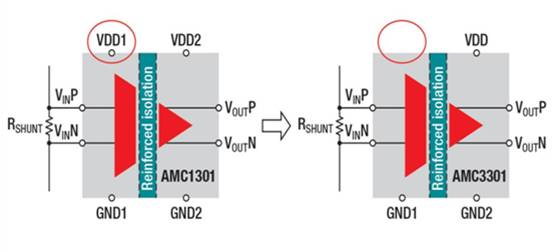“We all need an “it” in areas such as protecting personnel, noise immunity, and dealing with ground potential differences between subsystems. You can design “it” in applications such as motor drives, solar inverters, DC charging (pile) stations, industrial robots, uninterruptible power supplies, traction inverters, on-board chargers and DC/DC converters .
“
We all need an “it” in areas such as protecting personnel, noise immunity, and dealing with ground potential differences between subsystems. You can design “it” in applications such as motor drives, solar inverters, DC charging (pile) stations, industrial robots, uninterruptible power supplies, traction inverters, on-board chargers and DC/DC converters .
By “it” I mean galvanic isolation.
Many systems, including the ones I mentioned above, need to transmit current and voltage information from one power domain to another over an isolation barrier for monitoring and control. So how do you transfer analog information across the isolation barrier? The answer is to use isolated amplifiers and isolated analog-to-digital converters (ADCs), the latter also known as isolated delta-sigma modulators.
One of the challenges when designing these systems is how to power the isolation amplifier or ADC. Typically, they require two power supplies — a high-side supply and a low-side supply (shown as VDD1 and VDD2, respectively, on the left side of Figure 1). The low side is usually powered by the same power supply that powers the digital controller, but many systems have no power available on the high side.This means that discrete isolated power supplies must be designed on the high side (but this increases solution size, bill of materials[BOM]volume and solution cost), thereby increasing the complexity of the design and printed circuit board (PCB) layout.
To address this design challenge, we have developed a family of isolated amplifiers and ADCs that operate from low-side supplies. Figure 1 shows the difference between a standard isolated converter that requires two supplies (left) and the AMC3301 family that can operate from a single supply (right).

Figure 1: Traditional isolation amplifier vs. single-supply isolation amplifier
The new devices include a fully integrated DC/DC converter stage that generates the high-side power internally. The architecture of this DC/DC converter is optimized to provide auxiliary circuits such as active filters, preamplifiers, or comparators from a high-side low dropout regulator (LDO) output pin (usually denoted HLDOOUT) Additional DC current up to 1 mA.
Shunt-based current sensing provides high accuracy.
Learn more about the AMC3301 Precision Reinforced Isolation Amplifier with Integrated DC/DC Converter.
How Single-Supply Operation Simplifies Designs
The advantages of single-supply operation include:
・ Smaller solution size, reduced bill of materials (BOM), and lower system cost. Integrated DC/DC converters eliminate the need for discrete power supplies (such as dedicated isolated power supplies) and combinations of dedicated transformers, transformer drivers, and LDOs. This integration creates a compact system design for space-constrained applications and reduces BOM count and system cost.
・ Helps simplify design and layout. Designing accurate shunt-based current and voltage sensing is easier without worrying about the ability to use a high-side power supply. You can:
・ By eliminating the need for a centralized power supply, higher reuse rates can be achieved with modular PCB designs.
・ Enables dual-layer board designs with fewer traces and fewer power routings.
• Reduce design complexity when performing phase-to-phase voltage measurements in polyphase systems without a shared neutral. You can eliminate the need for discrete isolated power supplies.
• Flexibility in shunt arrangement. In traditional architectures, the high-side power supply dictates the shunt placement, which can lead to parasitic effects. For example, when using the gate driver supply as a high-side supply, the shunt cannot always be placed close to the switch pins. This non-optimal arrangement can increase parasitic inductance in series with the shunt, which can cause common-mode interference at the amplifier’s input during power stage switching, resulting in inaccurate measurements. When using the AMC3301 series, parasitic inductance does not affect measurement accuracy due to the integrated power supply.
TI’s product portfolio
Figure 2 summarizes TI’s portfolio of isolation amplifiers and ADCs. A conventional device requiring dual power supplies is shown on the left; a device operating from a single supply is shown on the right.

Figure 2: TI’s portfolio of isolation amplifiers and modulators (ADCs).
Below are all options for the AMC3301 family based on applications.
Current sensing:
・ AMC3301: ±250 mV input reinforced isolation amplifier.
・ AMC3301-Q1: Automotive Electronics Council (AEC)-Q100 qualified ±250mV input reinforced isolation amplifier.
・ AMC3302: ±50 mV input reinforced isolation amplifier.
・ AMC3306M25: ±250mV input reinforced isolation modulator (ADC).
Voltage Sensing:
・ AMC3330: ±1-V input reinforced isolation amplifier.
・ AMC3330-Q1: AEC-Q100 qualified ±1-V input reinforced isolation amplifier.
The Links: PAF600F280-24 SKIIP 11NAB12T4V1